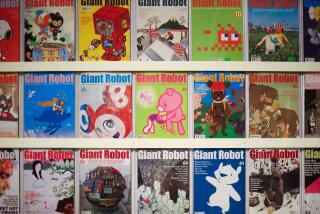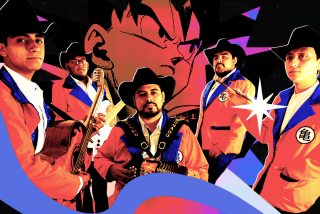Manga’s story starts with kamishibai
- Share via
It was the simple clacking of two wooden sticks on a street corner that signaled to children the start of kamishibai, a popular pastime during Depression-era Japan. Kamishibai means “street theater using painted illustrations.” Author Eric P. Nash examines the little-known art form and predecessor to modern-day anime and manga in his recent book “Manga Kamishibai: The Art of Japanese Paper Theater,” published by Abrams ComicArts.
Storytellers would travel from town to town with their butai (miniature stage) on the back of a bike. The set-up was reminiscent of a “Punch and Judy” show, but instead of puppets the narrator would slide a series of poster boards with water color illustrations in and out of the box. He would act out the script, which was written on cards placed on the back of a board.
Each show consisted of three stories of about 10 minutes each: an adventure for boys, a domestic drama for girls and then a simple comic story. The majority of performances ended in a cliffhanger, forcing eager audiences to return the next day.
Nash, a New York Times writer and research editor and author of several books on architecture, has always been a fan of comics. It was while reading the book “Getting it Wrong in Japan” that he came across “kamishibai,” a word he had never seen before, and decided to dig further. Unable to find any book on the topic in English, he traveled to Japan two years ago to investigate and found more than 300 images in two children’s libraries in Osaka and Tokyo and discovered countless contributions that kamishibai had made to the comics genre.
“A lot of attributes seen in anime are present,” Nash said, “such as Giant Robots and monsters from outer space.” He also mentions the “manga-sized eyes,” wide and oversized, meant to convey emotion found in popular characters such as Jungle Boy.
Golden Bat, created in 1931, was considered to be the world’s first true comic superhero. Although visually resembling Captain America’s nemesis Red Skull, Golden Bat and Superman share more commonalities: the red cape, skill of flight, superhuman strength and a fortress of solitude, albeit in the Japanese Alps.
Kamishibai artists departed from traditional Japanese line art drawing by creating a cartoon-like style and applying chiaroscuro, the Western style of contrasting light and dark, providing depth and mass.
During World War II, the Japanese government used kamishibai for propaganda, as did Americans during the occupation with stories centered on democratic values such as baseball.
The demise of kamishibai coincided with the end of the occupation and introduction of television in 1952.
Many of the form’s writers and artists then migrated into manga in the ‘50s such as Astro Boy creator Osamu Tezuka.
In “Manga Kamishibai,” Golden Bat creator Takeo Nagamatsu summed up his feelings on kamishibai‘s role in Japanese society: “Pictures that look nice in someone’s house are great . . . but kamishibai are loved by many children and cheer them up. When I think of these children later growing up to be honorable Japanese adults, it makes me realize the significance of creating kamishibai.”
More to Read
The biggest entertainment stories
Get our big stories about Hollywood, film, television, music, arts, culture and more right in your inbox as soon as they publish.
You may occasionally receive promotional content from the Los Angeles Times.










